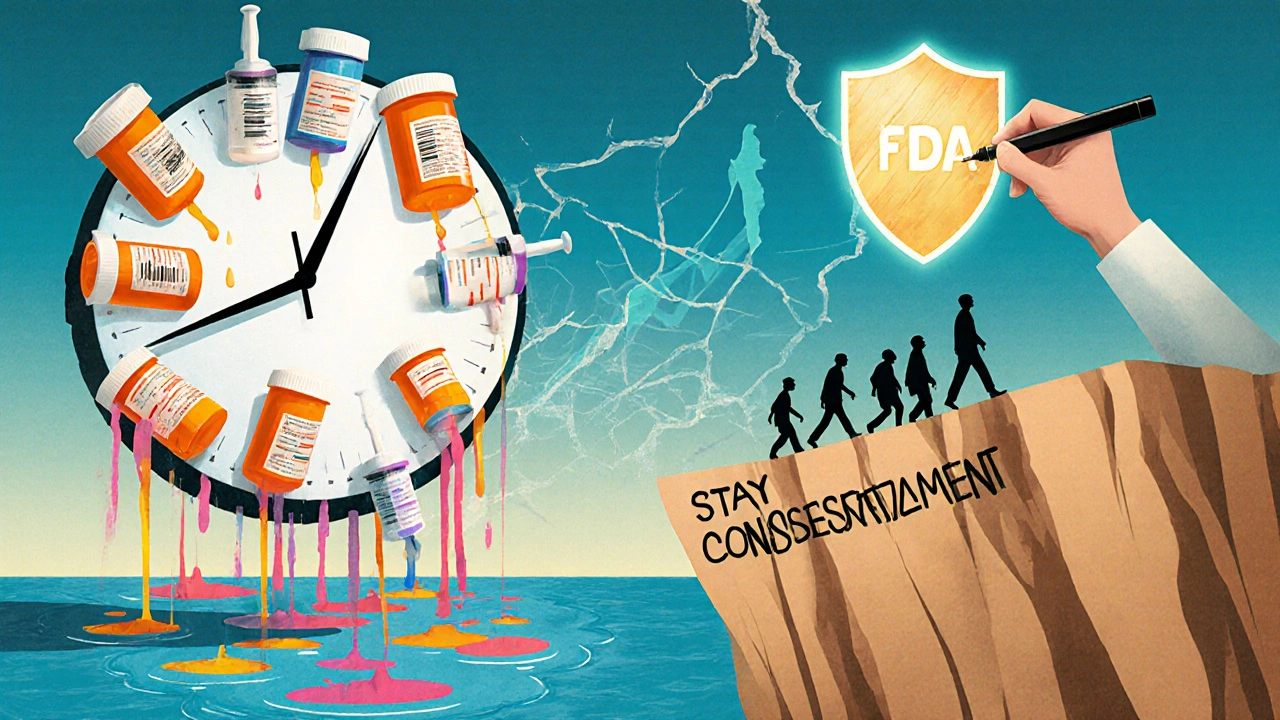Switching from brand-name drugs to generics is supposed to save money without sacrificing results. And for many people, it does. But what happens after six months? After a year? After five years? That’s where things get complicated - and where most patients and even doctors don’t have clear answers.
Why Switching to Generics Seems Like a No-Brainer
Generics make up over 90% of prescriptions filled in the U.S. today. The reason is simple: they cost a fraction of the brand-name version. A statin that used to cost $400 a month can drop to $4 with a generic. For people on fixed incomes, that’s life-changing. Medicare and private insurers push generics hard because they save billions. From 2008 to 2017, generic drugs saved the U.S. healthcare system $1.67 trillion. The FDA says generics are bioequivalent to brand-name drugs. That means they deliver the same active ingredient in the same amount, and the body absorbs it within a narrow range - 80% to 125% of the original drug’s levels. On paper, that sounds perfect. But bioequivalence is measured over a few weeks in healthy volunteers. It doesn’t tell you what happens when someone takes the same pill every day for 10, 15, or 20 years.The Hidden Gaps in the Science
Here’s the problem: almost no long-term studies exist. A 2016 review found that only 38% of studies comparing generics to brand-name drugs followed patients for more than six months. For chronic conditions like high blood pressure, epilepsy, or diabetes, treatment lasts decades. Yet the data we rely on comes from short-term trials. Some studies have started to uncover red flags. A 2017 Canadian study tracked patients switched to generic blood pressure meds like losartan and valsartan. In the first month after switching, adverse events jumped by 8% to 14%. Those higher rates didn’t go away - they stuck around for the full year. Another study in JAMA Internal Medicine found that generic drugs made in India had 27% more severe adverse events - including hospitalizations and deaths - compared to those made in the U.S., even when they were the same drug. It’s not about the active ingredient. It’s about the fillers, coatings, and manufacturing processes. These aren’t regulated as tightly. A 2021 study from the University of British Columbia found DNA-damaging contaminants in 37% of tested generic medications. These substances might not cause immediate harm, but over years of daily use, they could quietly affect liver function, mitochondrial health, or even increase cancer risk. We just don’t know yet.When Switching Breaks Your Routine
One of the biggest, least talked-about issues is pill appearance. If your generic switch changes the color, shape, or size of your pill, you might not even realize it. But your brain does. A 2020 University of Pittsburgh study found that 61% of patients felt confused or anxious when their pill looked different. One in five started taking their meds less consistently. This isn’t just about memory. For people with epilepsy, heart rhythm disorders, or thyroid disease, even tiny fluctuations in drug levels can trigger seizures, arrhythmias, or thyroid crashes. A 2013 study showed that changing pill appearance during a generic switch cut patient persistence - meaning how long they kept taking the drug - by 35% over 12 months. That’s not a small drop. That’s a major risk. Real patient stories back this up. On PatientsLikeMe, one user named HeartWarrior42 switched from brand-name metoprolol to a generic. Over 18 months, his heart rate control got worse. He had two hospitalizations for irregular heartbeat. When he switched back to the brand, his symptoms vanished. Another Reddit user, a pharmacist with 12 years of experience, says he’s seen multiple epilepsy patients go from perfectly controlled seizures to frequent breakdowns after switching to a generic - only to stabilize again when they went back to the original brand.
Not All Generics Are Created Equal
There’s a myth that all generics for a drug are the same. They’re not. Different manufacturers use different fillers, binders, and coating methods. Even the same generic from two different companies can behave differently in your body over time. That’s why experts like Dr. Aaron Kesselheim at Harvard say: “The assumption that all generics within a class are interchangeable for all patients over the long term is not fully supported by evidence.” The American Heart Association and the Agency for Healthcare Research and Quality both recommend sticking with one generic manufacturer once you’ve found one that works. Switching between different generic brands - even within the same drug class - increases the risk of adverse events by 40% if it happens more than three times in a year. For narrow therapeutic index drugs - like warfarin, levothyroxine, or phenytoin - this is especially dangerous. A small change in blood levels can be life-threatening. In Germany and France, automatic substitution of generics for these drugs is restricted. In the U.S., it’s still common - and dangerous.What You Can Do to Protect Your Health
If you’re on a chronic medication and your pharmacy switches your generic, here’s what to do:- Check the pill. Take a photo of your pill before switching. If the color, shape, or imprint changes, ask why.
- Ask for consistency. Tell your pharmacist: “I want to stay on the same generic manufacturer.” They can often request it.
- Track your symptoms. Keep a simple log: energy levels, heart rate, seizures, mood swings, dizziness. Note any changes in the first 30 days after a switch.
- Don’t accept automatic switches. Many pharmacy benefit managers force switches to cut costs. You have the right to refuse. Say: “I need to stay on my current generic.”
- Ask your doctor to document your generic manufacturer. Your EHR should list the exact brand of generic you’re on. Only 35% of U.S. clinics do this right now - but you can push for it.

The Bigger Picture: Cost vs. Long-Term Risk
Yes, generics save money. But if switching causes you to miss doses, end up in the hospital, or need more tests and doctor visits, those savings vanish. A 2015 study found that 64% of the time, total healthcare costs actually went up after switching to generics - because of increased complications. On the flip side, some drugs work just fine as generics. Statins are a great example. A 2006 study showed people were 77% more likely to stick with generic statins than brand-name ones. And their heart attack and stroke rates dropped by 8%. That’s a win. The difference? Statins are forgiving. A small change in blood level won’t cause a heart attack. But for drugs where precision matters - thyroid meds, seizure drugs, blood thinners - the margin for error is razor-thin.What’s Changing in 2025?
The FDA is finally starting to catch up. In 2023, they began requiring 36 months of stability data for generics used in chronic conditions - up from 24 months. They’re also spending $150 million on post-market monitoring of generic quality. The European Commission now requires safety studies for any generic that’s been used by over a million patients for more than a year. And the Institute for Safe Medication Practices is pushing to redefine “therapeutic equivalence” to include 24 months of real-world clinical outcomes - not just lab numbers. These changes won’t fix everything overnight. But they’re a start. The real solution? Personalized care. Not blanket substitution.Bottom Line: Generics Are Not One-Size-Fits-All
Switching to generics isn’t inherently bad. For many, it’s essential. But treating all generics as equal is a dangerous assumption. Your long-term health depends on consistency, not cost. If you’re on a daily medication for a chronic condition, don’t let a pharmacy change your pill without your say-so. Track how you feel. Ask questions. Demand to know which manufacturer you’re on. And if something feels off after a switch - trust your gut. It might not be in your head. It might be in your bloodstream.Are generic drugs as safe as brand-name drugs over the long term?
For many drugs, yes - especially statins and common blood pressure meds. But for narrow therapeutic index drugs like warfarin, levothyroxine, or epilepsy medications, long-term safety isn’t guaranteed. Bioequivalence tests only measure short-term absorption. They don’t track effects over years. Some generics contain different inactive ingredients or contaminants that may cause issues over time. Patient reports and emerging studies show increased adverse events after switching, especially when manufacturers change frequently.
Why do I feel worse after switching to a generic?
It could be several things. The generic may have different fillers or coatings that affect how your body absorbs the drug. Even small changes in blood levels can matter for drugs with a narrow therapeutic window. Also, if the pill looks different, you might unconsciously take it less consistently. Some patients report worsening symptoms after a switch - and feeling better again when they return to the original brand or a different generic manufacturer. This doesn’t mean the generic is fake; it means not all generics are identical in real-world use.
Can I ask my pharmacy to keep giving me the same generic brand?
Yes, absolutely. You have the right to request a specific generic manufacturer. Pharmacies often switch generics to cut costs, but you can say: “I’m stable on this version - please don’t change it.” Many pharmacists will honor this, especially if your doctor writes a note supporting consistency. If they refuse, ask to speak with the pharmacist-in-charge or request a paper prescription specifying the manufacturer.
Should I avoid generics altogether?
No. Generics have saved billions and made life-saving drugs accessible to millions. For drugs like metformin or atorvastatin, they work just as well. The issue isn’t generics - it’s automatic, frequent switching without monitoring. The goal is to find a generic that works for you, stick with it, and avoid unnecessary changes. Don’t fear generics - fear instability.
How do I know which generic manufacturer I’m getting?
Check the pill itself - the imprint code (letters/numbers on the tablet) identifies the manufacturer. You can search this code on websites like Drugs.com or use the NIH’s Pill Identifier tool. Your pharmacy’s label may list the manufacturer name, but it’s not always required. If you’re unsure, ask the pharmacist to tell you the name of the maker. Write it down and keep a note in your phone or wallet.
Are generics made in India or China less safe?
Some studies suggest yes. A 2021 JAMA study found generic drugs made in India had 27% higher rates of severe adverse events compared to U.S.-made versions. This doesn’t mean all Indian-made generics are unsafe - many are high quality. But manufacturing standards vary widely. The FDA inspects foreign plants less frequently than U.S. ones. If you’re on a critical medication, ask your pharmacist where your generic is made. If you’re concerned, ask if a U.S.-made version is available.
What should I do if my insurance forces me to switch generics?
Request a formulary exception from your insurer. Your doctor can submit a letter stating that switching has caused instability or adverse effects. Many insurers approve these exceptions, especially for chronic conditions. If they deny it, appeal in writing. You’re not alone - thousands have successfully fought forced switches. Keep records of symptoms, dates, and doctor notes. Your health is worth fighting for.





Nicole Ziegler
November 19, 2025 AT 12:24Just switched my levothyroxine to a generic last month and my energy dropped through the floor 😩
Started tracking my pulse and mood - big difference. Went back to my old brand and boom, back to normal. Not even kidding, it felt like a ghost left my body.
Bharat Alasandi
November 21, 2025 AT 12:14Bro, this is the real deal. I’m a pharmacist in Bangalore and I’ve seen this play out 100+ times. Generic metoprolol from one vendor? Perfect. Switch to another? BP spikes, fatigue, patients calling at 2am. The fillers? Totally different. FDA bioequivalence is a joke for chronic meds. We need batch-level tracking, not just ‘same active ingredient’ nonsense.
Kristi Bennardo
November 22, 2025 AT 03:43This post is an absolute disgrace. You’re scaring people out of life-saving medications based on anecdotal horror stories and fearmongering. Generics are rigorously tested. The FDA doesn’t approve junk. If you’re having issues, maybe your compliance is poor or you’re paranoid. Stop blaming the system - take responsibility.
Shiv Karan Singh
November 23, 2025 AT 13:05LOL so now we're worried about pill color? Next you'll say the shape affects your aura. Everyone knows generics are cheaper because they're not overpriced marketing fluff. If you can't handle switching from a blue pill to a white one, maybe you need therapy, not a new prescription.
Ravi boy
November 25, 2025 AT 08:56in india we get generics all the time and they work fine. i think the problem is usa pharmacy system not the drugs. i take generic atorvastatin since 2018 no issue. maybe u just need to chill and stop overthinking pills. also why so many words for something simple
Matthew Karrs
November 27, 2025 AT 00:09Of course they’re hiding the long-term effects. Big Pharma doesn’t want you to know generics have heavy metal contaminants. The FDA is bought. India and China are dumping toxic waste into pills. I’ve been on the same generic for 3 years and my liver enzymes are through the roof. No one talks about this because they’re all in on the scam.
Liam Strachan
November 28, 2025 AT 03:13Really appreciate this breakdown. I’ve been on warfarin for 12 years and switched generics once - my INR went wild. Took 3 weeks to stabilize. Now I only take the one made by Mylan. My pharmacist knows me by name. It’s not about being fancy - it’s about safety. Small changes matter more than people think.
Gerald Cheruiyot
November 29, 2025 AT 07:03What’s really being asked here is whether we value convenience over continuity. We’ve turned medicine into a commodity - buy the cheapest, swap it at will, don’t ask questions. But the human body isn’t a vending machine. For some drugs, consistency isn’t a luxury - it’s a biological necessity. Maybe the real cost isn’t the pill - it’s the erosion of trust in our own bodies.
Michael Fessler
November 30, 2025 AT 12:44As a clinical pharmacist, I’ve seen this too. Levothyroxine is the #1 offender. Even 5% variation in absorption can cause subclinical hypothyroidism. The problem? Pharmacists aren’t trained to track manufacturer changes. EHRs don’t log it. Patients don’t know to ask. We need mandatory manufacturer labeling on scripts - not optional. Also, the pill imprint trick? Gold. Teach this to every patient.
daniel lopez
December 2, 2025 AT 06:01Anyone who says generics are safe hasn’t read the FDA inspection reports. 60% of Indian plants have serious violations. The FDA doesn’t inspect them every year. You think your $4 pill is clean? It’s probably made in a factory with rats running through the powder. You’re not saving money - you’re gambling with your organs.
Nosipho Mbambo
December 3, 2025 AT 07:21Okay, but... why is this even a debate? You’re telling me that people are having adverse reactions - and yet the system keeps forcing switches? That’s not healthcare. That’s corporate negligence. I have a friend who had a seizure because they switched her phenytoin. She’s fine now - but she’s terrified. This isn’t ‘cost-saving.’ This is criminal.
Katie Magnus
December 4, 2025 AT 10:24Ugh. So now we’re supposed to care about which generic we get? I mean, come on. If you can’t afford the brand, you shouldn’t be on the drug at all. Just take the generic and stop whining. I bet you also cry when your toilet paper changes brands.
King Over
December 5, 2025 AT 21:47My pharmacist switched my generic without telling me. I didn’t notice until my anxiety spiked. Now I take a picture of every pill. If it looks different, I call the pharmacy. Simple. No drama. Just awareness. You don’t need a PhD to protect yourself.
Johannah Lavin
December 7, 2025 AT 09:29I just want to say thank you for writing this. I’ve been on levothyroxine for 15 years. I switched generics three times. Each time, I felt like I was drowning in fatigue. I cried the first time I went back to my original brand. It wasn’t just physical - it was emotional. I felt like my body finally remembered how to breathe. You’re not alone. And your experience? Valid. Always.